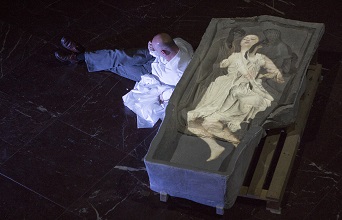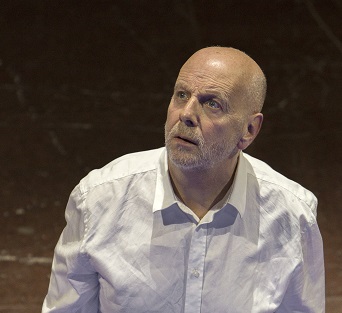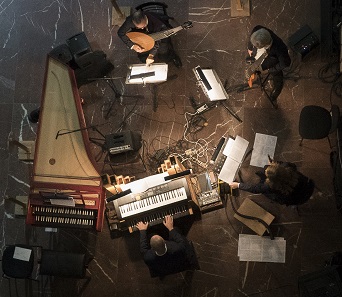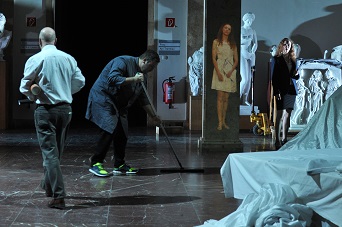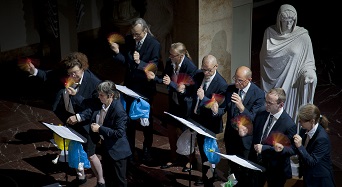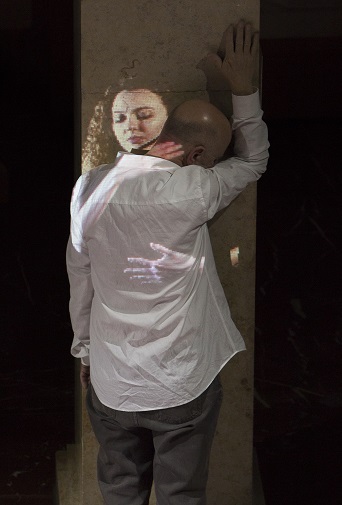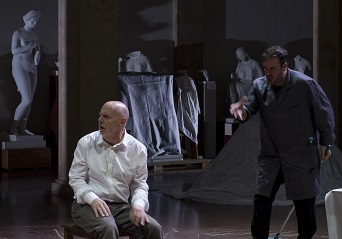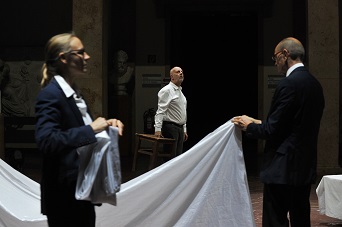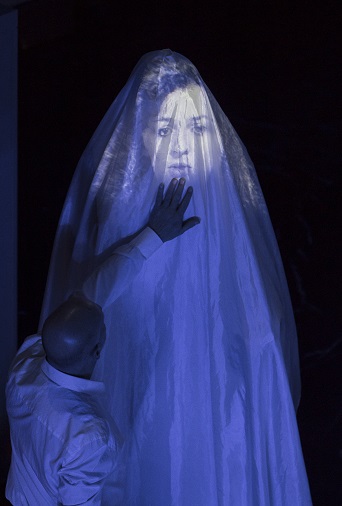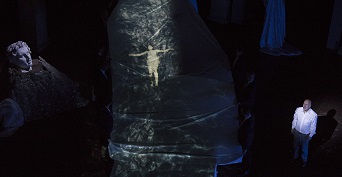2014 November 28th
STYX
Orfeo's past Now
A music theatre by Martina Veh and Christopher Robson
Music: Alexander Strauch /Claudio Monteverdi
Premiere (world premiere): Thursday, 27 November 2014 at 8.30 pm
at the Museum für Abgüsse Klassischer Bildwerke Munich (with the team of Dr. Ingeborg Kader)
Further performances: 28/29/30 November, 1 December and 1 December 2014 each at 8.30 p.m.
Information material in German as pdf
Video summary of the production mbm medienproduktion Michael Bieser
Musical direction/study: Nicholas Kok
Ensemble: United Continuo Ensemble
Director/Ideo/Concept: Martina Veh
Video/space: fettFilm
Video operator: Raphael Kurig,Thomas Mahnecke
Light/space: Benedikt Zehm
Photos Roy Hessing (pictures 1-3 , 5-7, 9, 10) Regine Heiland (pictures 4 , 8)
Stage: Stefan Wintersberger
Costume: Nikolaus Maier
Photos: Roy Hessing
Project management: Alexandra Zöllner
Participants:
KS Christopher Robson (Man and Orfeo respectively),
Florence Losseau - mezzo-soprano (Woman or Euridice),
Marios Sarantidis - baritone (cleaner or Caronte)
Vocal ensemble Cantar e Suonar, conductor: Anne Isenberg,
Jörg Meder - electric viola da gamba,
Axel Wolf - theorbo,
Friederike Otto - cornett
Content:
"Let, ye who enter here, all hope depart" (Dante, Divina Comedia).Hell in the everyday life of a museum employee: Orfeus has grown old and looks back. Hope keeps leading him by the nose and shifting his perception.He meets his wife Eurydice, who disappeared years ago, after he has been able to persuade Caronte, the ferryman, to ferry him across the STYX, the river of the underworld, with the help of his singing. The song does not fail to have an effect. Caronte willingly falls asleep. There in the underworld, the unreal illusory world of the Museum of Classical Castings, the encounter with the past becomes possible. Orfeus looks back. But this look back makes him lose his "now", to which he must nevertheless return again and again. His everyday life goes on. He prepares - as he often does - for a lecture event at the museum in the evening. And even there, in his distorted perception, he finds himself confronted with the messaggiera, the messenger, who in turn only announces the death of his beloved wife.Out of Orfeo's attempt to call memory - before disappearance - into the present once more, voices, movements, actions, images, poetic associations emerge, immersing the spectator in a field of experience of overlapping inner states.
Crossing Boundaries: Music/Staging/Video
"What has been and what has become is a yardstick for our own present: it creates distance to ourselves, enables refexion. It shows us alternatives to our life constraints and habits of thought, it frees us from the claim to absoluteness of the present." V.M. Strocka (archaeologist)
Crossing borders is a paradigm of our time. The motif of crossing borders finds its counterpart in our play in the mythical figure of Orpheus.Out of love for Eurydice, he succeeds in crossing the Styx, the last god-given border between life and death.We encounter the ancient myth in the everyday life of a museum employee who lives his life from memory.In the process, he increasingly loses touch with the "here and now": Orfeo's past now.
The musical/scenic basis of our premiere is based on the core of Monteverdi's "L'Orfeo" (1607). The flow of the musical realisation achieves a deep emotional access to the mental states of Orpheus through an apt basic mood.The focus of the production is on the constant play or transgression of the interface between the dimensions, inner world and outer world, now and past, reality and memory, stretching or questioning of temporal spaces, supported by the medium of video.
The video projections consist of a mixture of rather realistic imaginary worlds derived from the protagonist's everyday life and inventions that quote realistic events.
For example, in the video we encounter the time before Eurydice disappeared from Orpheus' life or the very individual perception of Orpheus becomes visible, who, for example, believes he recognises his Eurydice in the postwoman.
The content of the projections basically deals with the process of forgetting.Therefore, the red thread is the figure of Eurydice, who - except for one scenic encounter - appears exclusively via video.
Martina Veh
Music
How does a composer of the 21st century approach the music of Claudio Monteverdi? Because in doing so, the balance between composition and arrangement is difficult to maintain, given the instruments to be used, given the existing music, especially for the 'Favola di Orfeo' original building counter-tenor part.I have removed its foundation: the line of the basso continuo. Monteverdi's harmonies otherwise rested on this line, which is the playing level for every instrumental arrangement of an Orfeo performance.
This omission enabled me to add my own harmonies to the Orfeo melos used. By stationary focusing on e.g. extended or varied parts of the original line, combining my own lines for the "woman" and the "office baritone" - I prefer to dub Messagiera/Euridice and Caronte as they are less the Monteverdi parts but, like the countertenor, act in derivatives of these roles - windows are opened for my ways.
The meta-"woman", so far from the counter and yet so close, is kept lyrical throughout, the "office baritone" with his "rustling chorus" is situated between speaking and singing, just as Caronte connects upper world with underworld.
imilarly, the instrumentation is a bridge between yesterday and today: zinc, organ, theorbo, harpsichord and organ, partly in old mid-tone tuning, combine with electric viol and the quarter-tone synthesizer, the "old" standing for natural thirds and mid-tone fifths, the detuned synthesizer for natural seventh and natural tritone, which actually creates a different crystalline "beauty".
Formally, my music approaches Monteverdi in lines of a snake that gave Euridice the fatal bite in the myth, until at the beginning of the last third, his madrigal "Ohime il bel viso" is heard. Towards the end, a meadow of motifs, a canon of proportion interludio and a new setting of the proclamation of death bring us to the end, which once again takes up a fragment of the beginning, when the countertenor supposedly sees the glowing eyes of his shadowy wife.
Alexander Strauch
Commentary by Dr. Ingeborg Kader:
(Director of the Museum for Casts of Classical Works of Art, Munich)
What kind of world do we actually live in? This question is certainly justified today. The digital age with its limitless potential has buried the analogue age, left the Gutenberg galaxy behind, torn down imaginary borders, turned the world into a village, expanded our horizons into infinity, brought to light an undreamed-of treasure of human creativity and thus unleashed new creativity... Something has taken place in recent years that could be called a fulguration according to Konrad Lorenz: a leap in development that can no longer be logically derived from the previous material alone.
The virtual world that has sprung from technical aids has unhinged the claim to exclusivity of the ancient analogue world before everyone's eyes. Today, we not only think in several worlds, but also project our ideas quite naturally into parallel worlds, multiverses and new dimensions. And we no longer have to imagine this 'in our mind's eye', but can permanently view and experience it directly with a click.
Today, inside = outside and outside = inside. This attitude to life enables us in an unprecedented way to comprehend the real content of the ancient myth or of Plato's world of ideas. Plotinus already recognised that souls should naturally live in two worlds (amphibios) and hereby followed Heraclitus who said: "In change lies rest". The ancient Greeks surrounded themselves in their daily lives with images of beings from an otherworldly world that were not visible to the eyes of the human body. Why? Odysseus and Orpheus crossed the boundary from life to death as a matter of course in order to speak with the deceased. Did they know something that we have forgotten? Questions about questions, as red-hot as never before...
Gefördert von
der Landeshauptstadt München, der Ernst von Siemens Musikstiftung, dem Museum für Abgüsse Klassischer Bildwerke, B.O.A. Videofilmkunst
in Kooperation mit BR-Klassik, dem NeueMusikSalon der Münchner Volkshochschule
und der Hochschule für Musik und Theater München
Eine Produktion der Orpheus GbR und ZÖLLNER! Kulturprojekte

